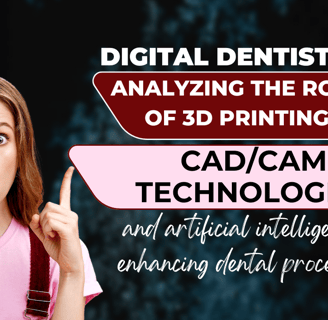Updent Publication: Where Knowledge Meets Innovation.
Digital Dentistry: Analyzing the role of 3D printing, CAD/CAM technologies, and artificial intelligence in enhancing dental procedures.
3D Printing: Tailored Solutions at Lightning Speed. CAD/CAM Technologies: The Era of Precision Dentistry. Artificial Intelligence: Transforming Dental Care. The Interconnected Future of Digital Dentistry. Overcoming Challenges and Building for Tomorrow.
DIGITAL DENTISTRY
Haider Afzal
3/25/20253 min read


Digital Dentistry: Analyzing the role of 3D printing, CAD/CAM technologies and Artificial Intelligence in enhancing Dental Procedures.
3D Printing: Tailored Solutions at Lightning Speed
3D printing, also known as additive manufacturing, is a groundbreaking technology reshaping dental practices.
Here’s how it's making waves:
1. Customized Dental Appliances: Traditional dental prosthetics often involved lengthy lab work and multiple visits. With 3D printing, custom dental models like aligners, crowns, and dentures can be produced in a fraction of the time. Digital impressions captured by intraoral scanners are directly fed into 3D printers, eliminating the inaccuracies of manual mold-taking.
2. Applications Beyond Prosthetics: 3D printing extends to surgical guides for implant placement, ensuring precise angulation and depth, which are critical for successful outcomes. It also enables bone grafting frameworks and temporary restorations, enhancing surgical efficiency.
3. Environmental and Economic Benefits: Additive manufacturing optimizes material use, reducing waste and environmental impact. In-house 3D printing setups further decrease reliance on third-party labs, cutting costs and improving accessibility for patients.
CAD/CAM Technologies: The Era of Precision Dentistry
CAD/CAM systems have redefined dental workflows by replacing conventional methods with streamlined digital solutions. Let’s delve into their significance:
1. Seamless Digital Workflows: The integration of intraoral scanners, CAD design software, and CAM milling units enables an all-digital workflow. This not only eliminates the need for physical impressions and manual adjustments but also delivers restorations with unrivaled accuracy.
2. Patient-Centered Care: Digital dentistry empowers patients to see the design and outcome of their treatment before any work begins. This visualization fosters trust and allows for collaborative decision-making.
3. Future Prospects: Advances in CAD/CAM technology are paving the way for automated restoration designs tailored to unique anatomical features. Real-time monitoring during milling processes ensures even greater precision.
Artificial Intelligence: Transforming Dental Care
The role of artificial intelligence extends beyond diagnostic accuracy—it is revolutionizing treatment strategies and practice management:
1. Early Diagnosis and Predictive Analytics: AI algorithms analyze imaging data with remarkable precision, identifying abnormalities like micro-cavities, fractures, and early signs of oral cancer that might be overlooked by the human eye. Predictive analytics also help assess the risk of developing conditions like periodontitis.
2. Personalized Treatment Plans: AI-driven systems tailor treatment plans based on patient histories, lifestyle factors, and genetic predispositions. This personalized approach not only optimizes outcomes but also enhances patient satisfaction.
3. Streamlined Practice Management: AI tools handle routine tasks like appointment scheduling, billing, and inventory management, freeing up dentists to focus on patient care. Chatbots and virtual assistants further improve patient communication and engagement.
The Interconnected Future of Digital Dentistry
The synergy among these technologies is creating a connected ecosystem that bridges the gap between patients and practitioners. For instance:
- The combination of 3D printing and AI enables faster, more accurate designs for dental prosthetics.
- CAD/CAM systems work seamlessly with AI to simulate treatment outcomes and guide fabrication.
As these tools become more integrated, they promise to make dentistry not only more efficient but also more patient-centric, offering tailored care that meets individual needs.
Overcoming Challenges and Building for Tomorrow
While the benefits of digital dentistry are clear, its widespread adoption comes with challenges:
- High Costs: Advanced equipment and training require significant investment, particularly for smaller practices.
- Learning Curve: Dentists and technicians must adapt to new workflows and technologies.
- Regulatory Hurdles: Approval processes for new materials and technologies can slow down adoption.
Despite these obstacles, the future is bright. As costs decrease and accessibility improves, even rural and underserved areas will be able to benefit from digital dental care. Looking ahead, we may see further innovations, such as:
- AI-Powered Robotics: Assisting with precise surgical procedures.
- 3D Bioprinting: Creating living tissues for regenerative dentistry.
- Cloud-Based Platforms: Enabling seamless collaboration among dental professionals worldwide.
In summary, digital dentistry is not just an evolution—it’s a revolution. By embracing 3D printing, CAD/CAM technologies, and artificial intelligence, the industry is stepping into a future where dental care is faster, more precise, and highly personalized. These advancements hold the potential to transform not only the way dentists work but also the experience of patients, making dental visits more comfortable, efficient, and effective.
